Reddix Center serves 279 students in grades 1-12.
The percentage of students achieving proficiency in math is ≥50% (which is lower than the Texas state average of 83%). The percentage of students achieving proficiency in reading/language arts is ≥50% (which is lower than the Texas state average of 88%).
The student:teacher ratio of 10:1 is lower than the Texas state level of 14:1.
Minority enrollment is 82% of the student body (majority Hispanic), which is higher than the Texas state average of 75% (majority Hispanic).
Quick Stats (2025)
- School Type: Alternative school
- Grades: 1-12
- Enrollment: 279 students
- Student:Teacher Ratio: 10:1
- Minority Enrollment: 82%
- Graduation Rate: ≤5% (Btm 50% in TX)
- Math Proficiency: ≥50%
- Reading Proficiency: ≥50%
- Source: National Center for Education Statistics (NCES), TX Dept. of Education
Top Rankings
Reddix Center ranks among the top 20% of public schools in Texas for:
Category
Attribute
Student Attention
School Overview
Reddix Center's student population of 279 students has grown by 20% over five school years.
The teacher population of 28 teachers has declined by 24% over five school years.
School Type
Grades Offered
Grades 1-12
Total Students
279 students
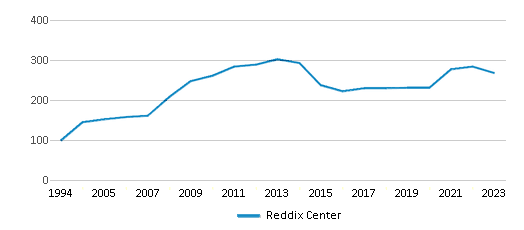
Gender %

Total Classroom Teachers
28 teachers
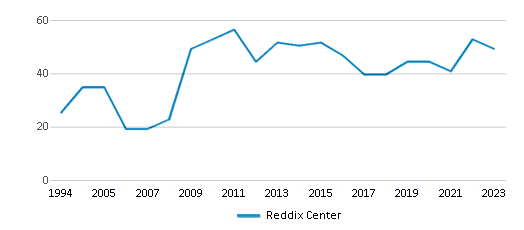
Students by Grade
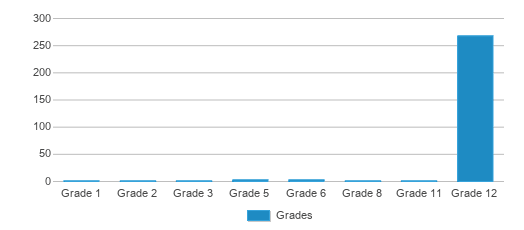
School Rankings
The diversity score of Reddix Center is 0.52, which is less than the diversity score at state average of 0.64. The school's diversity has stayed relatively flat over five school years.
Math Test Scores (% Proficient)
(09-10)≥50%
83%
Reading/Language Arts Test Scores (% Proficient)
(09-10)≥50%
88%
Student : Teacher Ratio
10:1
14:1
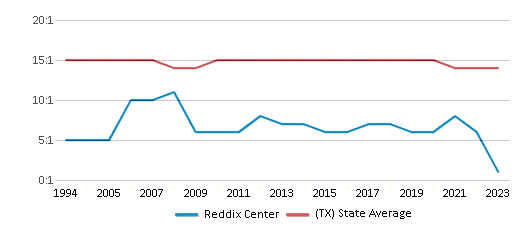
American Indian
n/a
n/a
Asian
1%
6%
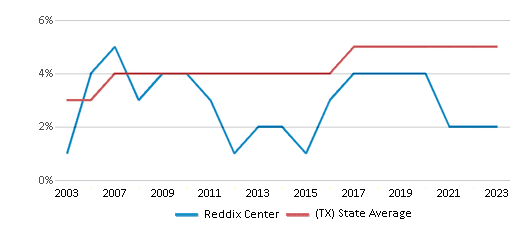
Hispanic
66%
53%
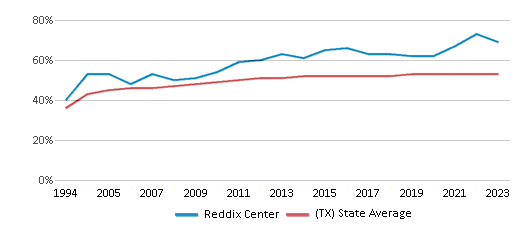
Black
11%
13%
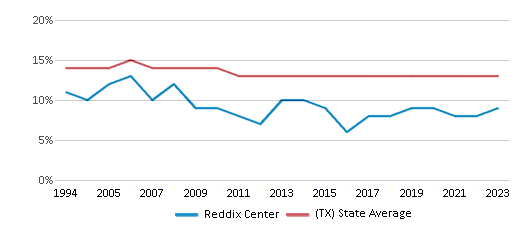
White
18%
25%
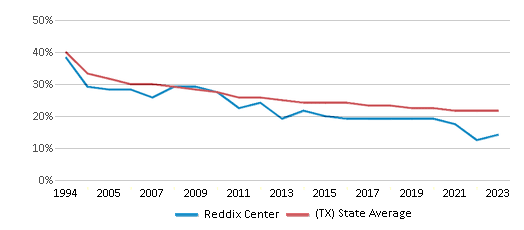
Hawaiian
n/a
n/a
Two or more races
4%
3%
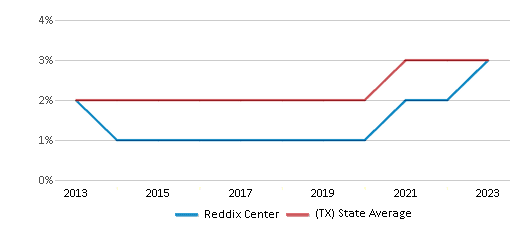
All Ethnic Groups
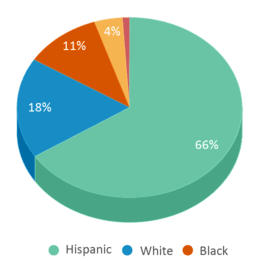

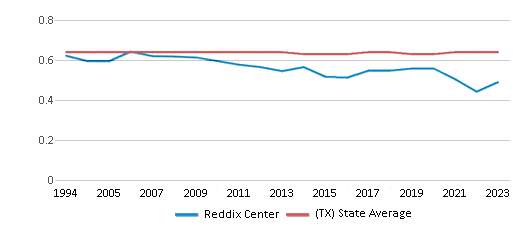
Graduation Rate
≤5%
90%
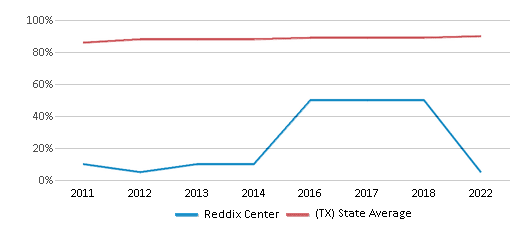
Participates in the National School Lunch Program (NSLP)
Yes
Eligible for Free Lunch
32%
57%
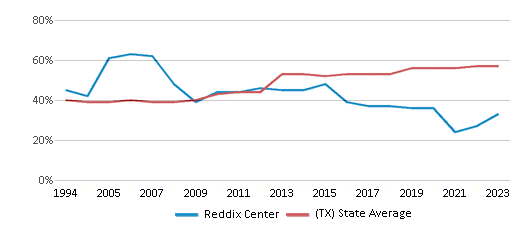
Eligible for Reduced Lunch
6%
5%
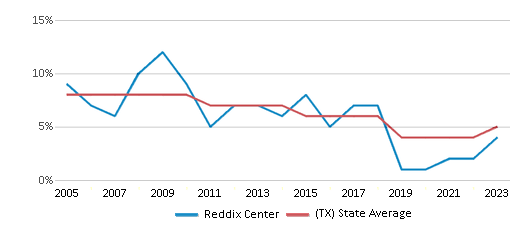
School Statewide Testing
School District Name
Source: National Center for Education Statistics (NCES), TX Dept. of Education
Profile last updated: 02/09/2025
Frequently Asked Questions
What percent of students have achieved state testing proficiency in math and reading?
≥50% of students have achieved math proficiency (compared to the 83% TX state average), while ≥50% of students have achieved reading proficiency (compared to the 88% TX state average).
What is the graduation rate of Reddix Center?
The graduation rate of Reddix Center is 5%, which is lower than the Texas state average of 90%.
How many students attend Reddix Center?
279 students attend Reddix Center.
What is the racial composition of the student body?
66% of Reddix Center students are Hispanic, 18% of students are White, 11% of students are Black, 4% of students are Two or more races, and 1% of students are Asian.
What is the student:teacher ratio of Reddix Center?
Reddix Center has a student ration of 10:1, which is lower than the Texas state average of 14:1.
What grades does Reddix Center offer ?
Reddix Center offers enrollment in grades 1-12
What school district is Reddix Center part of?
Reddix Center is part of Northside Independent School District.
In what neighborhood is Reddix Center located?
Reddix Center is located in the Northwest Side neighborhood of San Antonio, TX. There are 30 other public schools located in Northwest Side.
School Reviews
1 2/11/2021
Does not follow our sons IEP or ARD goals and achievements. Does not follow our son's health required food dietary needs. Claims to be helping our son with his goals towards adult living. However, in no sense can he tell us, explain, or show us how. Daily they make him recited the day, date, and how much money he is going to save out of his paycheck. However without setting him up to succeed or even have job, how is he going to save any money if he's not making any! The special needs students that attend his ''school'' see life in black and white, but all the staff does is talk in grey. They don't even attempt to understand or translate any sort of understanding to their ''students''.
Review Reddix Center. Reviews should be a few sentences in length. Please include any comments on:
- Quality of academic programs, teachers, and facilities
- Availability of music, art, sports and other extracurricular activities
Recent Articles

What Is A Charter School?
Explore the world of charter schools in this comprehensive guide. Learn about their history, how they operate, and the pros and cons of this educational innovation. Discover key facts about charter schools, including admission policies, demographics, and funding, as well as what to look for when considering a charter school for your child.

10 Reasons Why High School Sports Benefit Students
Discover the 10 compelling reasons why high school sports are beneficial for students. This comprehensive article explores how athletics enhance academic performance, foster personal growth, and develop crucial life skills. From improved fitness and time management to leadership development and community representation, learn why participating in high school sports can be a game-changer for students' overall success and well-being.

February 05, 2025
Understanding the U.S. Department of Education: Structure, Impact, and EvolutionWe explore how the Department of Education shapes American education, from its cabinet-level leadership to its impact on millions of students, written for general audiences seeking clarity on this vital institution.









